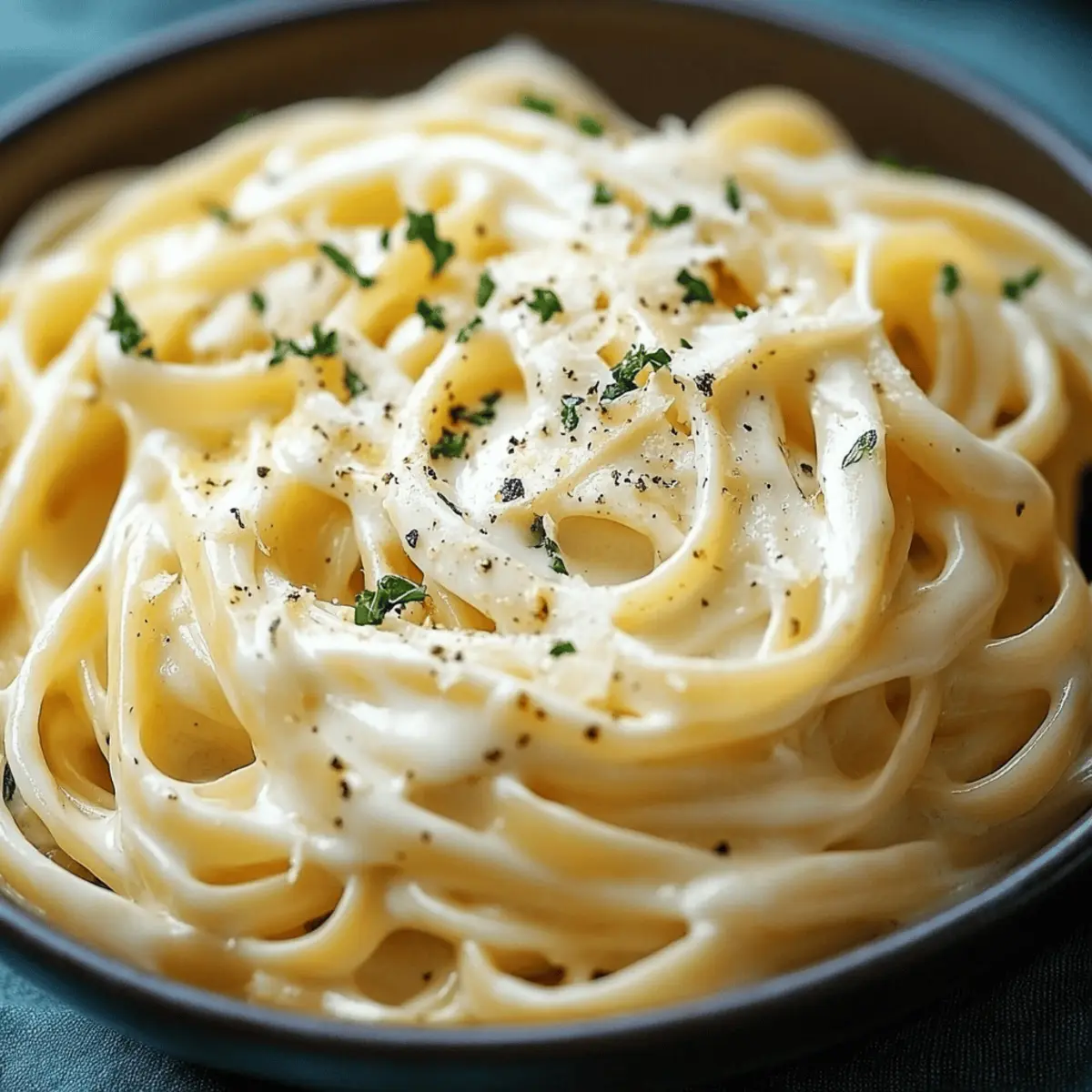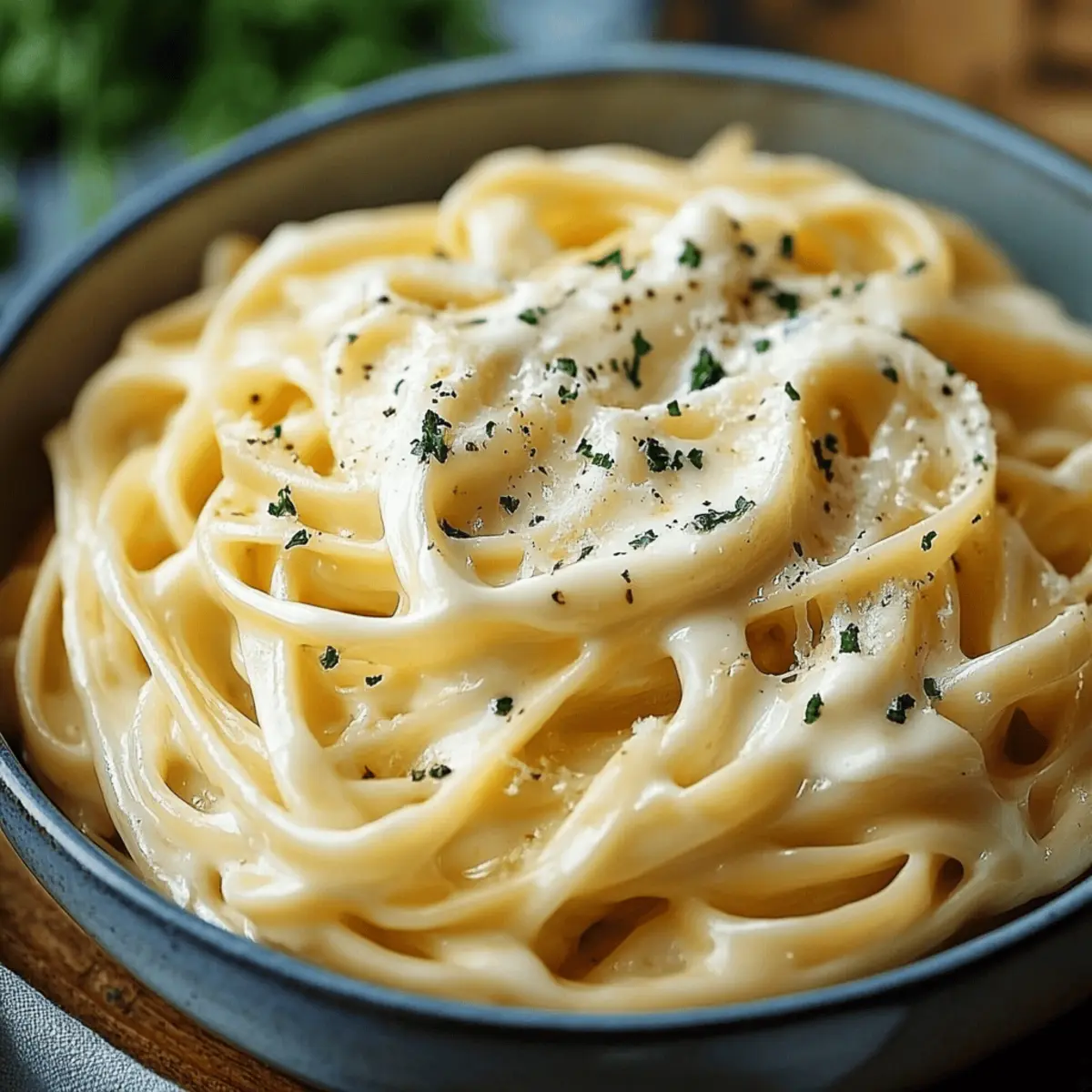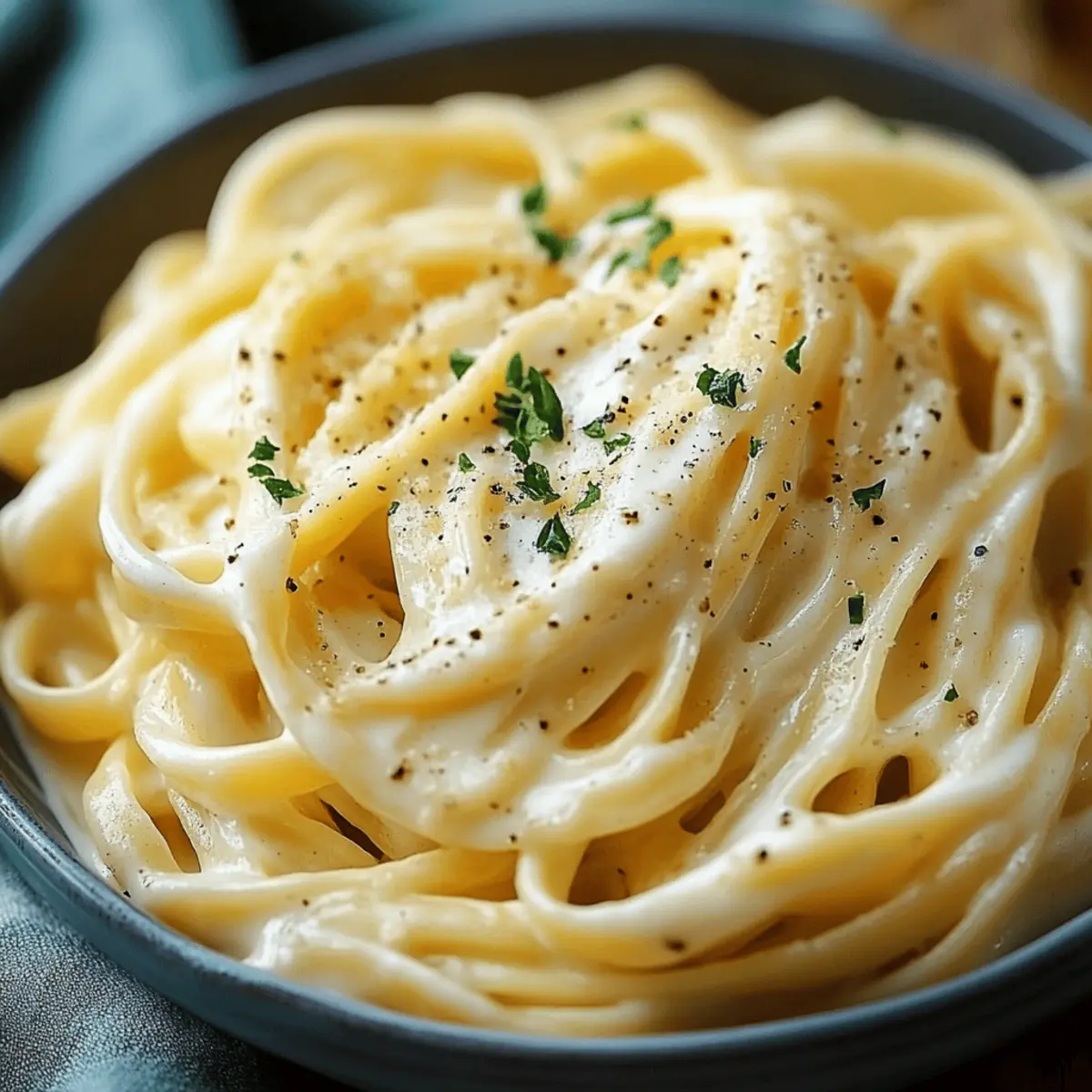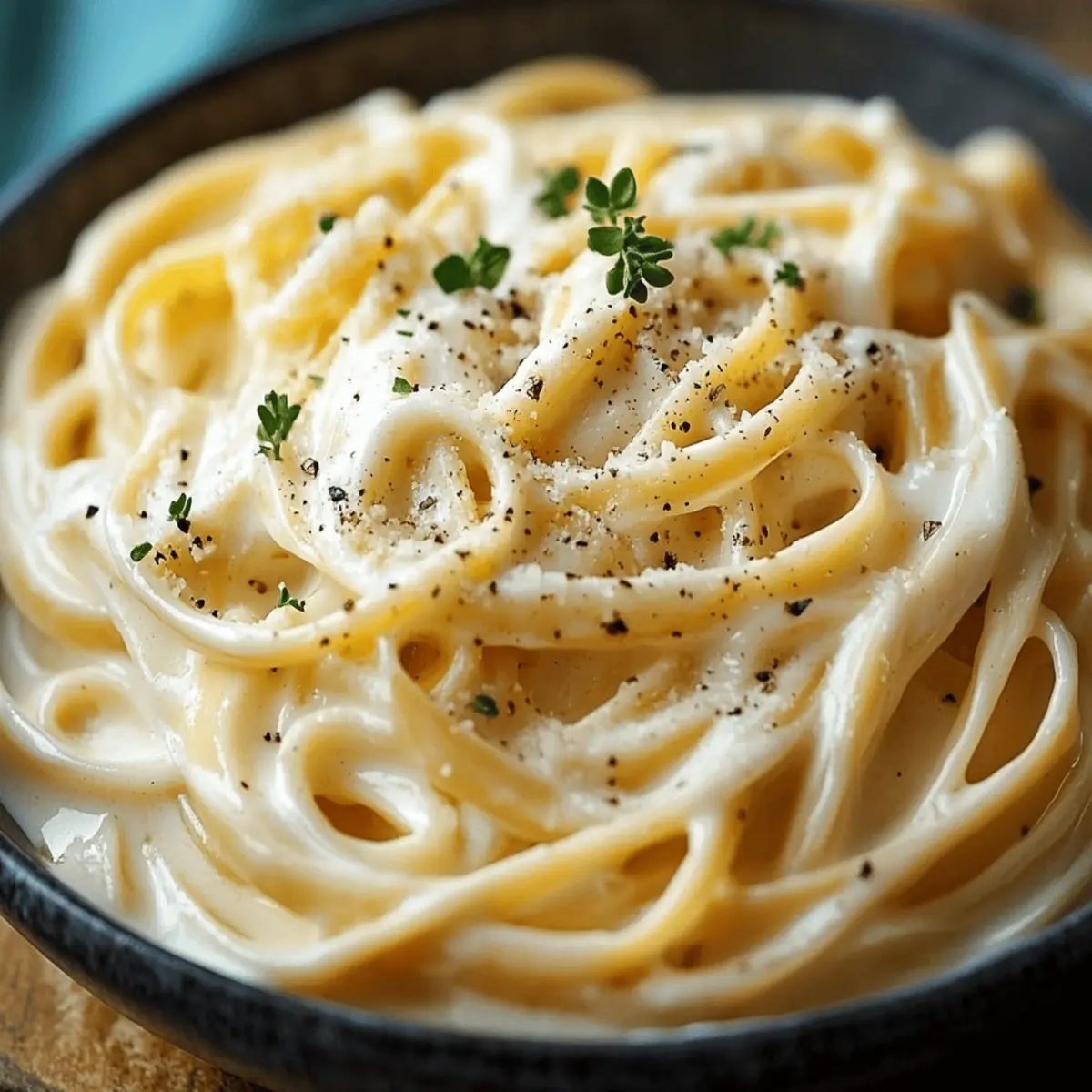In the bustling world of weeknight dinners, there’s a sense of triumph when you whip up something that not only satisfies but dazzles—and that’s exactly what Homemade Alfredo Sauce brings to the table. With just a handful of ingredients, this creamy delight elevates even the simplest pasta dish into an indulgent experience, making it perfect for both family dinners and special occasions. Its versatility means you can serve it over fettuccine, use it as a decadent pizza base, or even transform it into a luscious dip. The best part? It’s quick to prepare, allowing you to spend less time in the kitchen and more with the ones you love. Are you ready to bring a touch of Italian comfort to your weeknight meals? Let’s dive in!

What makes this Alfredo sauce unforgettable?
Simplicity: With just a handful of ingredients, this recipe is incredibly approachable for cooks of all skill levels.
Luxurious Creaminess: Each bite envelops your palate in rich, velvety goodness, transforming any dish into a restaurant-style experience.
Versatile Use: Whether you're drizzling it on pasta, using it as a pizza base, or creating a dip, the possibilities are endless!
Quick Preparation: In under 30 minutes, you can have this indulgent sauce ready, making it a perfect solution for busy weeknight dinners.
Crowd-Pleaser: This Alfredo sauce is sure to impress family and friends, ensuring everyone leaves the table satisfied and asking for seconds.
Alfredo Sauce Ingredients
• Create the perfect Alfredo sauce with a few simple yet essential ingredients!
For the Sauce
- Unsalted Butter – Provides richness and creaminess; you can use salted butter if needed, but adjust the salt in the recipe.
- Heavy Cream – Adds the necessary creaminess for the sauce; no direct substitutions for best results, but half-and-half can be used for a lighter option.
- Freshly Grated Nutmeg – Enhances the flavor profile; use ground nutmeg if fresh is unavailable, but fresh is preferred for optimal aroma.
- Freshly Grated Parmesan Cheese – Main cheese for flavor and texture; Parmesan Reggiano can be used for a more robust flavor.
- Freshly Grated Pecorino Romano Cheese – Adds savory depth; skip if unavailable or substitute with more Parmesan.
- Salt and Freshly Ground Black Pepper – Essential seasonings to taste; try using sea salt for better flavor integration.
- Fettuccine Pasta – Base for the sauce; pasta can be substituted with penne or another favorite noodle.
- Minced Garlic (optional) – Adds aromatic depth; leave out if you prefer less garlic flavor.
- Fresh Parsley (optional) – For garnish and color; swap in any fresh herb like basil for a delightful variation.
Step‑by‑Step Instructions for Alfredo Sauce
Step 1: Melt the Butter
Begin by melting ½ cup of unsalted butter in a heavy-bottomed saucepan over medium-low heat. Stir the butter gently, watching for it to foam and bubble, ensuring it melts evenly without browning. This will provide the rich base needed for your homemade Alfredo sauce.
Step 2: Sauté the Garlic (Optional)
If you’re using minced garlic, add it to the melted butter and sauté for about 30 seconds. Stir constantly until the garlic is fragrant but not browned, which signals the perfect aromatic foundation for your sauce. This step infuses an inviting flavor into the Alfredo sauce.
Step 3: Whisk in the Cream
Gradually whisk in 2 cups of heavy cream to the pan, increasing the heat slightly to warm everything through. Ensure the cream is combined smoothly with the butter, and heat it until just below a simmer—avoid boiling, as this can affect the sauce's texture.
Step 4: Simmer the Cream
Reduce the heat to low and let the cream simmer for 5–7 minutes. Stir occasionally and observe how the mixture thickens slightly. The sauce should start to take on a creamy consistency, ready to become the luxurious Alfredo sauce you crave.
Step 5: Add the Cheeses
Once the cream has simmered, remove the saucepan from heat and whisk in 1 cup each of freshly grated Parmesan and Pecorino Romano cheese. Stir vigorously until the cheeses are fully melted and the sauce is smooth and silky, embodying that classic, creamy Alfredo texture.
Step 6: Season the Sauce
With the cheese melted, it’s time to season your Alfredo sauce. Add a pinch of freshly grated nutmeg, salt, and black pepper to taste. Stir well to incorporate, allowing the flavors to blend beautifully, enhancing the overall richness of the homemade Alfredo sauce.
Step 7: Keep Warm
If you’re not serving the sauce immediately, keep it warm on the lowest heat setting. Occasionally stir, and if it thickens too much, add a splash of reserved pasta water to reach the desired consistency, ensuring your Alfredo retains its luxurious texture.
Step 8: Cook the Fettuccine
While the sauce simmers, bring a large pot of salted water to a boil. Cook 12 ounces of fettuccine until al dente according to package instructions, usually around 10-12 minutes. Reserve 1 cup of the starchy pasta water before draining the fettuccine.
Step 9: Combine Pasta and Sauce
Once the pasta is drained, immediately toss it with the creamy Alfredo sauce in the saucepan. Mix well until each strand of fettuccine is coated with the rich sauce. Adjust the consistency as necessary by stirring in some of the reserved pasta water.
Step 10: Serve and Garnish
Serve the homemade Alfredo sauce over the fettuccine in warm bowls. Create a beautiful finish by garnishing with additional cheese and fresh parsley for a pop of color. Enjoy the delightful comfort of your creamy Alfredo sauce, perfect for any occasion!

Expert Tips for Homemade Alfredo Sauce
-
Fresh Ingredients Matter: Use the freshest butter, cream, and cheeses for an unforgettable Alfredo sauce. Fresh ingredients greatly enhance the flavor and texture.
-
Avoid Boiling: Stir gently and heat the cream without boiling. Boiling can cause separation, resulting in a grainy sauce instead of that creamy smoothness you desire.
-
Save Pasta Water: Reserve some starchy pasta water before draining your noodles. It’s perfect for adjusting the sauce consistency, ensuring your Alfredo sauce clings to the pasta beautifully.
-
Whisk Constantly: When incorporating the cheeses, whisk vigorously. This helps to achieve that luxurious, creamy finish you're aiming for, preventing any lumps from forming.
-
Season to Taste: Start with a little salt and gradually season your sauce as needed. Each ingredient can add its own saltiness, especially cheeses, so taste as you go for the best flavor.
What to Serve with Homemade Alfredo Sauce
Transform your mealtime into a delightful culinary experience with these perfect pairings.
-
Creamy Mashed Potatoes: The fluffiness and buttery flavor beautifully complement the richness of the Alfredo sauce. Perfect for those cozy nights in!
-
Garlic Bread: Crunchy and warm, this classic side offers an irresistible contrast to the sauce's creaminess. Dip each bite into your leftover Alfredo for an extra treat!
-
Sautéed Spinach: Adding a vibrant, fresh element, sautéed spinach brings a pop of color. Its earthiness balances the sauce's luxurious texture, making every bite delightful.
-
Grilled Chicken: Juicy chicken works wonderfully alongside Alfredo, bringing protein to the table. You can slice it and toss it right with your fettuccine for a full meal!
-
Caesar Salad: The zesty Caesar salad offers a light and refreshing counterpoint to the creamy Alfredo. Crisp greens and parmesan come together in this perfect appetizer.
-
Roasted Vegetables: Keep it colorful with roasted Brussels sprouts or asparagus. Their caramelized edges and earthy taste make a delightful contrast to the creamy sauce.
-
Red Wine: A glass of chilled Chardonnay pairs beautifully, its acidity cutting through the richness of the sauce and complementing your meal perfectly.
-
Chocolate Mousse: For dessert, this light and airy treat will round off your indulgent meal. Its smooth texture mirrors the Alfredo sauce while providing a decadent finish.
How to Store and Freeze Alfredo Sauce
Fridge: Store leftover Alfredo sauce in an airtight container in the refrigerator for up to 3 days. Reheat gently on low heat, adding a splash of milk or reserved pasta water to restore its creamy texture.
Freezer: You can freeze Alfredo sauce for up to 2 months. Allow it to cool completely, then transfer to a freezer-safe container. Thaw overnight in the fridge before reheating.
Reheating: When reheating Alfredo sauce, do so over low heat while stirring continuously. To bring back the creamy consistency, incorporate small amounts of milk or reserved pasta water as needed.
Airtight Storage: Ensure your container is airtight to avoid freezer burn when storing in the freezer, preserving the delicious flavor of your homemade Alfredo sauce.
Make Ahead Options
Homemade Alfredo Sauce is a fantastic choice for meal prep, saving you time during busy weeknights! You can prepare the sauce up to 24 hours in advance. Simply follow the recipe until the cheese is melted, then cool the sauce and transfer it to an airtight container to refrigerate. When you're ready to serve, gently reheat the sauce over low heat, adding a splash of milk or reserved pasta water to restore its creamy texture. Additionally, you can cook the fettuccine up to 3 days ahead and store it in the refrigerator. Just remember to mix the sauce and pasta right before serving for that distinct freshness!
Alfredo Sauce Variations & Substitutions
Feel free to make this delicious Alfredo sauce your own with these delightful twists and swaps that elevate flavor and accommodate dietary needs!
- Dairy-Free: Use almond or coconut milk with nutritional yeast instead of heavy cream and cheeses for a creamy, vegan-friendly option.
- Lighter Sauce: Substitute half-and-half for heavy cream to reduce calories while maintaining a silky texture. Your taste buds won’t know the difference!
- Extra Flavor: Stir in a teaspoon of smoked paprika or a splash of white wine for a unique depth and enhance the richness of the sauce.
- Veggie Delight: Add sautéed mushrooms, spinach, or broccoli for added nutrition. The vibrant colors and textures make for a beautiful presentation!
- Zesty Twist: Incorporate a squeeze of lemon juice for a refreshing brightness, balancing the creaminess with a zesty zing that enlivens every bite.
- Heat Things Up: Mix in some crushed red pepper flakes or a dash of hot sauce for a spicy kick. A little heat can transform the whole dish!
- Cheesy Fusion: Experiment with different cheeses like goat cheese or cheddar for a fun flavor transformation that adds a gourmet touch.
- Seafood Add-On: Toss in seared scallops or shrimp directly into the sauce for a rich seafood dish that elevates your Alfredo experience to new heights.
By tailoring these ideas to your taste, you'll create an Alfredo sauce that's truly unforgettable, perfect for every occasion! For even more ways to enjoy this creamy delight, consider drizzling it over roasted vegetables or using it as a luscious dip for crusty bread.

Homemade Alfredo Sauce Recipe FAQs
How do I pick the right butter for my Alfredo sauce?
Absolutely! Unsalted butter is the best choice for homemade Alfredo sauce, as it provides richness without excess salt that could complicate flavor balance. If you only have salted butter, don't worry; just adjust the salt added to your sauce to taste.
How long can I store leftover Alfredo sauce in the refrigerator?
You can safely store leftover Alfredo sauce in an airtight container in the fridge for up to 3 days. When you're ready to enjoy it again, simply reheat it on low heat, adding a splash of milk or reserved pasta water to help restore its creamy texture.
Can I freeze Alfredo sauce? How do I do it properly?
Yes, you can freeze Alfredo sauce for up to 2 months! First, allow the sauce to cool completely. Then, transfer it to a freezer-safe container, making sure it's airtight to prevent freezer burn. When you're ready to use it, thaw it overnight in the fridge. To reheat, do so gently over low heat and incorporate small amounts of milk or pasta water to regain the desired creaminess.
What if my Alfredo sauce turns out grainy or separates?
Very! If you find your sauce is grainy or has separated, it may have boiled too vigorously or the ingredients weren't mixed properly. To fix it, return the sauce to low heat and whisk in a bit of milk or reserved pasta water, stirring continuously until smooth. If necessary, blend the sauce with an immersion blender to achieve a silky texture.
Is this Alfredo sauce suitable for individuals with lactose intolerance?
While this homemade Alfredo sauce is rich and delicious, it does contain dairy, making it unsuitable for those with lactose intolerance. I often recommend using lactose-free cream and cheese substitutes if you'd like a similar creamy taste without the discomfort. Enjoy experimenting!

Indulgent Homemade Alfredo Sauce for Creamy Comfort
Ingredients
Equipment
Method
- Begin by melting ½ cup of unsalted butter in a heavy-bottomed saucepan over medium-low heat, stirring gently until melted.
- If using minced garlic, add it to the melted butter and sauté for about 30 seconds until fragrant.
- Gradually whisk in 2 cups of heavy cream, increasing the heat slightly to warm through without boiling.
- Reduce the heat to low and let the cream simmer for 5–7 minutes until slightly thickened.
- Remove from heat and whisk in 1 cup each of freshly grated Parmesan and Pecorino Romano cheese until smooth.
- Season the sauce with a pinch of nutmeg, salt, and pepper to taste, stirring well.
- Keep the sauce warm on low heat while cooking the pasta.
- Cook 12 ounces of fettuccine in salted boiling water according to package instructions, reserving 1 cup of pasta water before draining.
- Immediately toss the drained pasta with the Alfredo sauce, adjusting the consistency with reserved pasta water as needed.
- Serve the sauce over fettuccine, garnishing with additional cheese and fresh parsley.




Leave a Reply